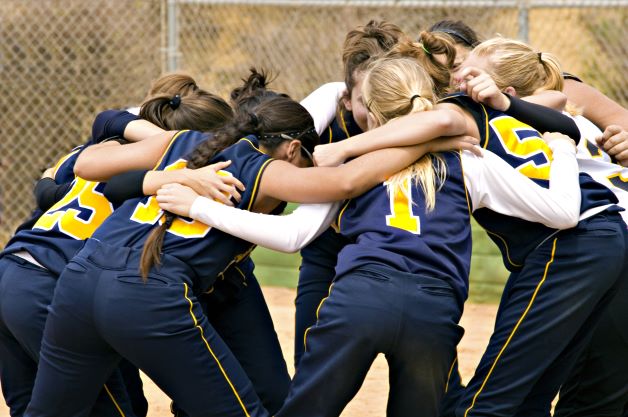
Are you trying to teach your teens soft skills?
Recently we were at a birthday party for some family friends. It was for an older couple, and many of the other guests were several decades older than my husband and me. Our children are under the age of 16, so we were probably the only ones there under 35.
As the evening went on, many of the attendees engaged my children in the conversation that is typical of a big age gap.
The most popular questions included, “What are your favorite subjects in school?” “Do you play any sports?” and to my teenager, a few even ventured bolder inquiries such as “Do you have a boyfriend?” (asked with a little wink and a sly smile) and “Have you started to think about college?“
I hovered a bit, primarily out of my own curiosity about how they would answer, but for the most part, I left them on their own to manage the interrogations.
As the night went on, several of the guests made a point of coming over to us and complimenting our children.
Do you want to know the number one thing they said to us?
“It was so nice that your children made eye contact with us when they spoke.”
This was often followed by statements about how young kids today are so busy looking down at those $&!?% cell phones, they don’t even know how to look a person straight in the eye anymore!
Are Teens Today Missing Essential Life Skills?
I was not surprised by what they had to say.
There is a lot of talk about today’s younger generations and the basic life skills they are missing.
But often when most parents think of life skills, tasks like doing their own laundry or knowing how to actually prepare a basic meal are the things that come to mind.
Now, those are absolutely essential skills. If our kids can’t feed themselves, they aren’t going to survive long on their own.
You may also like to read: How to Help Teens Build the Life Skills They Need for School-Life Balance
But we want our kids to do more than just survive, right?
We want our kids to thrive as adults. And to do that, they need to know more than how to run the dishwasher or prepare mac and cheese.
Enter Soft Skills for Teens
This is where soft skills come in, which is the number one thing that everyone from teachers and coaches to professors and employers say our kids are lacking.
Hard skills are easy to quantify or list out. You can usually learn these in a classroom or from a textbook. They can include abilities like proficiency in a foreign language or in computer programing, knowing how to operate machinery, or having passed certain certifications and / or training.
So, what exactly are “soft skills?” They basically include all the ways in which we interact with other people as well as the character traits that enable someone to navigate their world and meet goals in an effective way. Some people simply call this common sense, but it’s a little more than that.
Also, there is a myth that these are characteristics people are born with and that can’t be taught, but that is not true at all. Everything from increasing empathy to improved decision-making can be taught and grown with practice.
There are plenty of ways we can nurture these skills in our children from toddlerhood to the teen years and beyond.
9 Essential Softs Skills for Teens and Tweens
Do you feel the pressure of getting your teens ready to launch into this world? You want them to be able to proudly stand on their own two feet and show this world all that they can do.
Here are the 9 soft skills for teens and tweens that will be essential to their success.
1. Communication
“Words are singularly the most powerful force available to humanity.”
– Yehuda Berg
When I was growing up, it was a big privilege at my house when you were finally allowed to answer the phone! My sister and I were coached in taking a message and all the right phrases to say such as, “My Mom’s not available right now, may I take a message?” or “Hello, yes, she’s right here!”
Tweens and teens today communicate in more ways than any other generation in history.
Technology has opened exciting doors with email, texting, and social media. In all of these advances, kids rarely use the telephone anymore, yet phones are still a large part of corporate America.
My daughter’s teacher was telling me the other day how no one in her 10th grade homeroom knew how to properly answer the landline phone in their classroom last year. They’d pick it up, say hello, and then look rather puzzled and hand it to the teacher.
But good communication skills go beyond phone dialogue: knowing when to ask for help, basic small talk, and being clear and concise in face-to-face interactions, not just digital ones, are key for anyone’s success. Communication also means understanding active listening and controlling your emotions in a disagreement. Finally, learning how to lead with a positive attitude when dealing with other people can make a huge difference.
Knowing how to communicate effectively is important in nearly every job in every workplace, ranging from a customer service representative and retail supervisor to doctors and engineers.
Practice these skills with your kids. Role-play how a conversation should sound and give them scripts to use for interactions. And most importantly, if you have an opportunity for them to call and speak with someone, do it!
2. Eye Contact (and a Firm Handshake)
“The majority of teenagers don’t even make eye contact with people, even people of the same age.”
– Saoirse Ronan
Another HUGE element of communication is being able to look someone in the eye when talking to them.
Have you ever interacted with some of your children’s friends and when you say “hi” or ask a question, they stare at their feet or look away when answering you? Many parents dismiss this as their adolescents simply being shy or they write it off as immaturity. Rarely are these the real reasons.
Just like teaching your child to say “please” and “thank you”, eye contact is part of basic manners that must be taught, encouraged, and reinforced. As children get older and they aren’t able to do this, it will negatively impact the way they are perceived in all areas of their life.
Furthermore, teens need to start getting used to shaking hands as they meet new people. Shaking hands is commonplace in a job interview, in networking events, or when they want to make a good first impression meeting the parents of a significant other. Looping in a proper handshake with a conversation about eye contact is a good idea at this age and developmental stage.
*Note, eye contact for children and adults who are on the spectrum, are neurodivergent, or may have other differences or disabilities can be challenging. You should never publicly reprimand someone for a lack of eye contact.
By middle school, a young person should be able to do the following, while maintaining good eye contact:
- Greet guests when they come to your home (friends, family, the mailman, etc.)
- Order their own food at restaurants
- Approach teachers with concerns or questions
- Give oral presentations in school
- Talk to their peers (yes, they should be looking at their friends when they talk to them)
- Engage adults in social situations such as church, parties, school functions, etc.
- Answer for themselves at appointments such as the doctor, the dentist or even at hair appointments
3. Advocate For Themselves With Authority Figures (the soft skill that keeps on giving)
“I learned a long time ago the wisest thing I can do is be on my own side,
be an advocate for myself and others like me.“
– Maya Angelou
This is one of the most important soft skills for teens. During childhood, parents take on most of the responsibility for stepping in when our children are struggling in school or on a sports team and talking with the adults involved. But as our children head into the middle school years and beyond, it’s time for us to start backing off and letting our children manage these relationships on their own.
For instance, when my daughter was a 7th grader, she struggled with completing a large project. She didn’t seem to understand the parameters required for an assignment that would count for 45% of her science grade.
I repeatedly encouraged her to seek clarification from the teacher on her own, even though I could easily have sent a quick email to resolve the questions. She was resistant at first, but when she realized I wasn’t going to intervene, she stepped up and sought the answers she needed.
I was willing to let her face the natural consequences (a poor grade) if she chose not to advocate for herself. This can be difficult for any parent, but I was convinced the long-term benefit of her independence outweighed a subpar middle school grade.
Now that this same daughter is in high school, I rarely communicate with her teachers as she knows it is her responsibility to seek help with any issues, and she now has the self-confidence and good judgment to handle it herself.
Sports is another great place to learn advocacy.

Let’s say your son is not getting the field time he once was. Encourage him to approach the coach in a non-confrontational way and ask about the reduction in playing time and what he needs to do to change that situation.
Chances are, the coach will be more than willing to provide a reason and suggestions for improvement. The next steps are on his shoulders. He can take responsibility to meet those expectations or ignore the feedback and suffer the resulting natural consequences.
You may also like to read: 7 Lessons Middle School Athletes Learn through Sports (And None Are About Winning)
4. Flexibility and Teamwork
“The ability to recognize opportunities and move in new – and sometimes unexpected – directions will benefit you no matter your interests or aspirations.”
– Drew Gilpin Faust
Being able to adapt to changes in schedule, assignments, and the ability to easily switch gears allows your tween and teen to be a team player.
This can be difficult to flat out “teach” your child, but life generally throws enough curveballs that’s you’ll likely have opportunities to model these behaviors.
Sports can be a wonderful place to hone this skill. Playing various positions, dealing with weather delays, coaching decisions, and even learning to “ride the bench” are all markers on the flexibility journey.
But really any group activity can help a teen deal with navigating relationships and collaboration will foster their soft skill of teamwork. There are a lot of opportunities for middle and high school students to work in groups: Orchestra, band, scouts, clubs, volunteer organizations, etc. all provide an opportunity to work with different types of people.
This can translate to being able to deal with deadline shifts, reassignments of responsibility, challenging co-workers, and business practices in the corporate world.
Having a strong-willed, creative, idea-driven child has also shown me that sometimes we have to help our kids be able to accept and value ideas that aren’t her own.
Being open to new methods and other ways of accomplishing a goal are things she has had to work on throughout middle school. Humbling herself to the realization that her way isn’t always the right way or the only way has been a difficult lesson. But it’s taught her how to work better with others and certainly made her group project experiences far more positive.
5. Resilience and Problem Solving (a soft skill we need so much in today’s world)
“In order to succeed, people need a sense of self-efficacy, to struggle together with resilience to meet the inevitable obstacles and inequities of life.”
– Albert Bandura
Stress is a part of life. Mistakes, failures, unpleasant classmates and teachers, and even tragedy and loss will be experiences that are inevitable for most of our children.
It is tempting to want to shield them from as much of this as possible and to intervene on their behalf when they are frustrated, hurt, or struggling. We want our kids to be happy.
But in our attempts to make sure our children’s lives are always happy and pain-free, we send our children unintended messages.
Our interference says loud and clear that we don’t have faith in them to solve their own problems. That we don’t believe they are strong enough to handle hard things. Or in some cases, that others are to blame for their shortcomings.
The result of our good intentions is kids who are fearful and give up easily or who end up entitled and irresponsible.
You might also like to read: Here Are 20 Easy and Healthy Coping Skills for Teens
At some point, we must give our kids the chance to develop the necessary coping skills to manage the ups and downs of life. When we do, the result is confident kids who feel empowered to tackle even the toughest situations.
Additionally, critical thinking is an important problem-solving component to learning how to manage people and be more productive. Being able to understand a problem and think creatively on how to solve it can be an extremely marketable skill in the workforce. Critical thinking also provides a level of self-awareness that helps us evaluate ourselves and others.
6. A Strong Work Ethic
“Working hard becomes a habit, a serious kind of fun. You get self-satisfaction from pushing yourself to the limit, knowing that all the effort is going to pay off.”
– Mary Lou Retton
Employers are increasingly concerned about the lack of work ethic seen in young professionals entering the workforce. Oftentimes, young people are showing up late, missing deadlines, and often don’t want to put in the extra time and effort that is sometimes required to make sure a job gets done right. Yet, these same employees expect promotions they haven’t earned and compensation at the levels of peers with far more experience.
College professors and high school educators see the roots of this in their classrooms. They are quick to point out that their students often only work to meet the basic requirements of an assignment, rather than striving to do their best work. Also, due to grade inflation and parental pressure, children are often awarded grades that aren’t deserved.
Having a strong work ethic is an important component to workforce success. Whether in school, on the field, or climbing the corporate ladder, being dependable, showing initiative, and going above and beyond to deliver your best possible work are the keys to real success. It’s also how one finds real satisfaction and fulfillment.
With that said, it’s also important that our kids grow up to know that they also should not work for free and that they deserve to feel valued when they are putting in their best effort. Finding that balance between being a good employee and expecting to be treated as such is an important life skill.
One of the best ways to teach a good work ethic is via chores.
For instance, my 6th-grade son is responsible for the vacuuming at our house. He is required to complete it twice a week, Tuesdays and Saturdays, with no reminder from me (showing dependability).
We have tried to help him learn to be proactive and go beyond just the minimal expectations when it comes to his chores. We’ve explained that if he sees the carpet needs vacuuming when it’s not his assigned day, he’s still expected to take care of it (initiative). This is an ongoing conversation and training process at our house, and although he’s not perfect at it, he’s way better than when he started.
Does he enjoy vacuuming? Um, No. Does anyone really? But it’s his responsibility and if it’s not completed, he loses a privilege.
Related: 10 Tween Chores Your Middle Schooler Needs For Survival
7. Responsibility / Organization (the cross-section of life and soft skills)
“The price of greatness is responsibility.”
– Winston Churchill
If all goes according to plan, someday in the future this child of yours should grow up, get a job and be able to take care of themself. It’s scary and something many of us don’t want to think about.
But preparing our kids for this eventuality is kind of a fundamental part of the parenting job description.
Luckily, we have somewhere between 18 and 21 years, give or take, to get them there.
The road to self-sufficiency starts when they are very young with simple things like teaching them to dress themselves, having them pick up their toys, and getting them to help with family responsibilities.
But as they move into their tweens and teens, our expectations should begin to greatly increase. This is when they need to begin taking on a much bigger role in managing their own lives.
Time management is a great place to start, and teens should be able to complete (or at least be working on) the following:
- Setting an alarm and getting themselves up in the morning
- Keeping track of their own school schedule and homework due dates
- Remembering when they have practice and being able to get all their own gear together
- Making their own breakfast and lunch each day
These are all reasonable expectations for kids in middle and high school.

Of course, a little bit of grace or an occasional reminder is okay.
But we should not be jumping in to save our kids when they aren’t stepping up.
Suffering the consequences of being late to school, receiving a poor grade for a missed homework assignment, or being benched for coming to practice without their uniform will motivate them to do better next time.
As moms, it is difficult to watch our kids mess up. But we know we won’t be following them to college, setting their alarms, and ushering them out the door so they don’t miss biology class.
Our goal is to raise an independent adult—and teaching them to take responsibility for themselves is one key step on that path.
8. Conflict Resolution
“If you have learned how to disagree without being disagreeable, then you have discovered the secret of getting along–whether it be business, family relations, or life itself.”
– Bernard Meltzer
I can’t even tell you the number of times when my daughter was little that I would hear the words “Well, then I’m not going to be your friend anymore,” after she and one of her besties had a disagreement.
In the world of five-year-olds, this is to be expected. Plus, most of the time, five minutes later they’ve made up and all was forgotten.
However, as they get older, this method of dealing with people who have upset or angered them becomes less and less effective.
It is also as our children become tweens and teens that they go through what will probably be one of the most drama-filled and conflict-ridden stages of their life. The teen years are ripe with opportunities for conflict resolution.
Teaching them how to handle conflict is essential. This includes knowing when to walk away, but doing it appropriately. And it also includes gracefully refusing to engage, rather than stomping away or running to their bedroom and slamming the door.
Also, conflict resolution means knowing when to stay and fight. But by fight, we mean having a reasonable discussion with a proper tone of voice and appropriate language.
While teaching such self-restraint to a hormonal adolescent may seem daunting, remember it doesn’t have to happen overnight.
You will be surprised how many great examples there are to show them in day to day life.
Parents are the primary role models for teenagers. Don’t be afraid to let them see you disagree and how you are able to work things out.
TV shows are also an excellent teaching ground. As you watch shows together, ask them questions about how they think characters handled certain encounters with other characters.
When it comes to conflicts in their own relationships with siblings, friends, or teachers, coach them through positive ways to handle these interactions. If siblings are arguing, instead of jumping into the middle, encourage them to figure it out themselves. I often tell my kids that they will be far happier coming up with a solution on their own than they will be if I get involved. And they will tell you from experience, I’m usually right about this one. (Cleaning toilets together is no fun.)
As for their peers or adults in their lives, coach them through potential scenarios, have them write down what they might say, or even role-play it with them so they are comfortable.
9. Risk-Taking
“During the first period of a man’s life, the greatest danger is not to take the risk.”
– Soren Kierkegaard
Is risk-taking really a soft skill for teens?
This one can sound scary, but the ability to take calculated risks is one of the most essential soft skills for teens and tweens. At this point in their lives, they need to be asserting their independence and trying new things. We simply need to be there to pick them up if they fall, dust them off, and send them right back at it.
Talk to any successful entrepreneur or professional and they’ll tell you they’ve had to take a variety of risks to get where they are today.
You can encourage this in your kids in a number of ways, such as trying a new sport, auditioning for theater productions, joining a new club, or even asking someone new to hang out. It’s important to always be challenging our kids to try new things and go outside of their comfort zone. This can mean trying new foods, speaking up in class, or participating in a physical challenge.
Most importantly, however, is modeling healthy risk-taking for our teens.
For example, I’m not an athletic, outdoorsy person but every summer we vacation in the mountains. I enjoy sitting on a peaceful porch, reading a great book, and reveling in the cool temperatures when it’s 100 degrees back home in Florida.
However, I plan a couple of adventurous activities each year to demonstrate risk-taking to my children.
We’ve gone hiking and gotten lost for hours. Then there was white water tubing (imagine white water rafting but in an inner tube… slightly crazy). And, we’ve jumped off giant boulders into freezing waters.
Not every experience was stellar, and we certainly enjoyed some far more than others, but we were never sorry we gave it a go.
By going outside my comfort zone, I’ve shown my children that taking risks isn’t so scary.
Now they are much more willing to do so all on their own (which is a whole other version of being outside my comfort zone!)
You may also like to read: 7 Simple Ways to Let Your Big Kid Take Healthy Risks
Continuous Learning of Soft Skills
The great thing about soft skill development is you can always be working on them at home and anywhere else you are with your teens.
And more importantly, you can see the results of your efforts as your tweens and teens transition to adulthood.
Raising teens is hard, but you don’t have to do it alone. Here are some other good articles you may enjoy:
Tired of Yelling at Your Teen to Get Off Their Phone? Try This Trick Instead
25 Holiday Activities That Will Make Your Teen Actually Want To Hang Out With You
Parenting Teens Means Dealing with Their Bad Choices
When you are in the thick of raising teens and tweens, we recommend Loving Hard When They’re Hard to Love by Whitney Fleming. In Loving Hard When They’re Hard to Love, blogger Whitney Fleming shares her favorite essays about raising three teenagers in today’s chaotic world. Written from the perspective of a fellow parent, each story will leave you with tears in your eyes and hope in your heart because someone else is saying exactly what’s been going through your mind.

*This post may contain affiliate links where we earn a small commission for purchases made from our site.







Great article with practical tips! Raising middle schoolers and spending lots of time volunteering at their schools has only confirmed everything in this article. These skills are so needed!